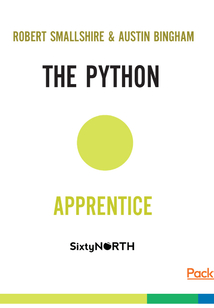舉報 

會員
The Python Apprentice
最新章節:
Uninstalling Packages
ThePythonApprenticeisforanyonewhowantstostartbuilding,creatingandcontributingtowardsaPythonproject.NopreviousknowledgeofPythonisrequired,althoughatleastsomefamiliaritywithprogramminginanotherlanguageishelpful.
目錄(340章)
倒序
- coverpage
- Title Page
- Credits
- About the Authors
- www.PacktPub.com
- Customer Feedback
- Preface
- Python Promo
- Overview
- What is Python?
- It's a programming language!
- Versions of the Python language
- It's a standard library!
- It's a philosophy
- The journey of a thousand miles…
- Errata and Suggestions
- Conventions Used in This Book
- Downloading the example code
- Downloading the color images of this book
- Getting started
- Obtaining and installing Python 3
- Windows
- macOS
- Linux
- Starting Python command line REPL
- Leaving the REPL
- Windows
- Unix
- Code structure and significant indentation
- Python culture
- Importing standard library modules
- Getting help()
- Counting fruit with math.factorial()
- Different types of numbers
- Scalar data types: integers floats None and bool
- int
- float
- Special floating point values
- Promotion to float
- None
- bool
- Relational operators
- Rich comparison operators
- Control flow: if-statements and while-loops
- Conditional control flow: The if-statement
- if...else
- if...elif...else
- Conditional repetition: the while-loop
- Exiting loops with break
- Summary
- Strings and Collections
- str – an immutable sequence of Unicode code points
- String quoting styles
- Moment of zen
- Concatenation of adjacent strings
- Multiline strings and newlines
- Raw strings
- The str constructor
- Strings as sequences
- String methods
- Strings with Unicode
- The bytes type – an immutable sequence of bytes
- Literal bytes
- Converting between bytes and str
- list – a sequence of objects
- The dict type – associating keys with values
- The For-loops – iterating over series of items
- Putting it all together
- Summary
- Modularity
- Organizing code in a .py file
- Running Python programs from the operating system shell
- Importing modules into the REPL
- Defining functions
- Organizing our module into functions
- The __name__ type and executing modules from the command line
- The Python execution model
- The difference between modules scripts and programs
- Setting up a main function with command line argument
- Accepting command line arguments
- Moment of zen
- Docstrings
- Comments
- Shebang
- Executable Python programs on Linux and Mac
- Executable Python programs on Windows
- Summary
- Built-in types and the object model
- The nature of Python object references
- Reassigning a reference
- Assigning one reference to another
- Exploring value vs. identity with id()
- Testing for equality of identity with is
- Mutating without mutating
- References to mutable objects
- Equality of value (equivalence) versus equality of identity
- Argument passing semantics – pass by object-reference
- Modifying external objects in a function
- Binding new objects in a function
- Argument passing is reference binding
- Python return semantics
- Function arguments in detail
- Default parameter values
- Keyword arguments
- When are default arguments evaluated?
- The Python type system
- Dynamic typing in Python
- Strong typing in Python
- Variable declaration and scoping
- The LEGB rule
- Scopes in action
- Identical names in global and local scope
- The global keyword
- Moment of zen
- Everything is an object
- Inspecting a function
- Summary
- Exploring Built-in Collection types
- tuple – an immutable sequence of objects
- Literal tuples
- Tuple element access
- The length of a tuple
- Iterating over a tuple
- Concatenating and repetition of tuples
- Nested tuples
- Single-element tuples
- Empty tuples
- Optional parentheses
- Returning and unpacking tuples
- Swapping variables with tuple unpacking
- The tuple constructor
- Membership tests
- Strings in action
- The length of a string
- Concatenating strings
- Joining strings
- Splitting strings
- Moment of zen
- Partitioning strings
- String formatting
- Other string methods
- range – a collection of evenly spaced integers
- Starting value
- Step argument
- Not using range: enumerate()
- list in action
- Negative indexing for lists (and other sequences)
- Slicing lists
- Copying lists
- Shallow copies
- Repeating lists
- Finding list elements with index()
- Membership testing with count() and in
- Removing list elements by index with del
- Removing list elements by value with remove()
- Inserting into a list
- Concatenating lists
- Rearranging list elements
- Out-of-place rearrangement
- Dictionaries
- Copying dictionaries
- Updating dictionaries
- Iterating over dictionary keys
- Iterating over dictionary values
- Iterating over key-value pairs
- Membership testing for dictionary keys
- Removing dictionary items
- Mutability of dictionaries
- Pretty printing
- set – an unordered collection of unique elements
- The set constructor
- Iterating over sets
- Membership testing of sets
- Adding elements to sets
- Removing elements from sets
- Copying sets
- Set algebra operations
- Union
- Intersection
- Difference
- Symmetric difference
- Subset relationships
- Collection protocols
- Container protocol
- Sized protocol
- Iterable protocol
- Sequence protocol
- Other protocols
- Summary
- Exceptions
- Exceptions and control flow
- Handling exceptions
- Handling multiple exceptions
- Programmer errors
- Empty blocks – the pass statement
- Exception objects
- Imprudent return codes
- Re-raising exceptions
- Exceptions are part of your function's API
- Exceptions raised by Python
- Catching exceptions
- Raising exceptions explicitly
- Guard clauses
- Exceptions APIs and protocols
- IndexError
- ValueError
- KeyError
- Choosing not to guard against TypeError
- Pythonic style – EAFP versus LBYL
- Clean-up actions
- Moment of zen
- Platform-specific code
- Summary
- Comprehensions iterables and generators
- Comprehensions
- List comprehensions
- List comprehension syntax
- Elements of a list comprehension
- Set comprehensions
- Dictionary comprehensions
- Comprehension complexity
- Filtering comprehensions
- Combining filtering and transformation
- Moment of zen
- Iteration protocols
- An example of the iteration protocols
- A more practical example of the iteration protocols
- Generator functions
- The yield keyword
- Generators are iterators
- When is generator code executed?
- Maintaining explicit state in the generator function
- The first stateful generator: take()
- The second stateful generator: distinct()
- Understand these generators!
- Lazy generator pipelines
- Laziness and the infinite
- Generating the Lucas series
- Generator expressions
- Batteries included iteration tools
- Introducing itertools
- Sequences of booleans
- Merging sequences with zip
- More than two sequences with zip()
- Lazily concatenating sequences with chain()
- Pulling it all together
- Summary
- Generators
- Iteration tools
- Defining new types with classes
- Defining classes
- Instance methods
- Instance initializers
- A lack of access modifiers
- Validation and invariants
- Adding a second class
- Collaborating classes
- Moment of zen
- Booking seats
- Allocating seats to passengers
- Naming methods for implementation details
- Implementing relocate_passenger()
- Counting available seats
- Sometimes the only object you need is a function
- Making Flight create boarding cards
- Polymorphism and duck-typing
- Refactoring Aircraft
- Inheritance and implementation sharing
- A base class for aircraft
- Inheriting from Aircraft
- Hoisting common functionality into a base class
- Summary
- Files and Resource Management
- Files
- Binary and text modes
- The important of encoding
- Opening a file for writing
- Writing to files
- Closing files
- The file outside of Python
- Reading files
- Readline line by line
- Reading multiple lines at once
- Appending to files
- File objects as iterators
- Context Managers
- Managing resources with finally
- The with-blocks
- Moment of zen
- Binary files
- The BMP file format
- Bitwise operators
- Writing a BMP file
- Reading binary files
- File-like objects
- You've already seen file-like objects!
- Using file-like objects
- Other resources
- Summary
- Unit testing with the Python standard library
- Test cases
- Fixtures
- Assertions
- Unit testing example: text analysis
- Running the initial tests
- Making the test pass
- Using fixtures to create temporary files
- Using the new fixtures
- Using assertions to test behavior
- Counting lines
- Counting characters
- Testing for exceptions
- Testing for file existence
- Moment of zen
- Summary
- Debugging with PDB
- Debugging commands
- Palindrome debugging
- Bug hunting with PDB
- Finding infinite loops with sampling
- Setting explicit breaks
- Stepping through execution
- Fixing the bug
- Summary
- Afterword – Just the Beginning
- Virtual Environments
- Creating a virtual environment
- Activating a virtual environment
- Deactivating a virtual environment
- Other tools for working with virtual environments
- Packaging and Distribution
- Configuring a package with distutils
- Installing with distutils
- Packaging with distutils
- Installing Third-Party Packages
- Installing pip
- The Python Package Index
- Installing with pip
- Installing Local Packages with pip
- Uninstalling Packages 更新時間:2021-07-02 22:17:48
推薦閱讀
- Getting Started with Citrix XenApp? 7.6
- AngularJS Testing Cookbook
- JavaScript+jQuery網頁特效設計任務驅動教程(第2版)
- Java游戲服務器架構實戰
- 深入淺出Android Jetpack
- Java Web基礎與實例教程
- Learning Apache Kafka(Second Edition)
- Redis Essentials
- Quantum Computing and Blockchain in Business
- 軟件體系結構
- 邊玩邊學Scratch3.0少兒趣味編程
- C#程序設計基礎入門教程
- Python物理建模初學者指南(第2版)
- Java RESTful Web Service實戰
- Python自動化運維:技術與最佳實踐
- Learning Java by Building Android Games
- Vue.js從入門到精通
- 跟著迪哥學Python數據分析與機器學習實戰
- 零基礎學:微信小程序開發
- 細說PyTorch深度學習:理論、算法、模型與編程實現
- The Data Science Workshop
- Hands-On Artificial Intelligence on Google Cloud Platform
- Java Web程序設計(慕課版)
- INSTANT Kendo UI Mobile
- HTML5從入門到項目實踐(超值版)
- C語言程序設計習題集與上機指導(第四版)
- 高性能響應式Web開發實戰
- Python黑帽子:黑客與滲透測試編程之道(第2版)
- Java Web輕量級開發全體驗
- Mastering Jenkins

